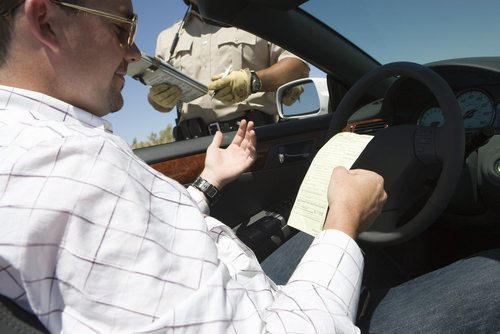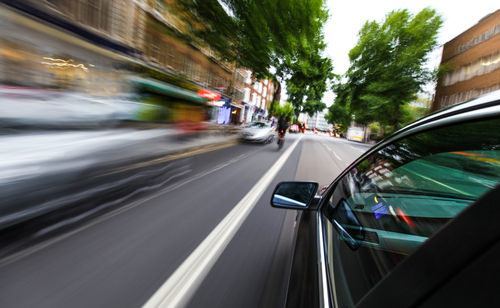California Vehicle Code 22400 VC — the minimum speed law — prohibits you from slowing or stopping as to impede the normal flow of traffic. You also cannot drive at below an established minimum speed limit.
The language of the code section states that:
22400 VC. (a) No person shall drive upon a highway at such a slow speed as to impede or block the normal and reasonable movement of traffic unless the reduced speed is necessary for safe operation, because of a grade, or in compliance with law.
No person shall bring a vehicle to a complete stop upon a highway so as to impede or block the normal and reasonable movement of traffic unless the stop is necessary for safe operation or in compliance with law.
(b) Whenever the Department of Transportation determines on the basis of an engineering and traffic survey that slow speeds on any part of a state highway consistently impede the normal and reasonable movement of traffic, the department may determine and declare a minimum speed limit below which no person shall drive a vehicle, except when necessary for safe operation or in compliance with law, when appropriate signs giving notice thereof are erected along the part of the highway for which a minimum speed limit is established.
Subdivision (b) of this section shall apply only to vehicles subject to registration.
In the article below, our California auto accident attorneys will address:
- 1. Minimum Speed Laws
- 2. Defenses
- 3. Penalties
- 4. Traffic School
- 5. Infractions Are Not Crimes
- 6. Ignoring Your Ticket
- 7. Can I be sued?
- 8. Related Offenses

Driving too slowly is against the law.
1. Minimum Speed Laws
VC 22400(a) prohibits you from slowing or stopping on California roadways so as to impede the normal flow of traffic.1 When determining whether you violated this law, judges consider all the relevant circumstances.2 These include:
- The posted maximum speed limit;
- The number of lanes on the highway;
- The weather;
- The driving conditions;
- The amount of traffic; and,
- The time of day (or night) that you were driving.3
Meanwhile, Vehicle Code 22400 (b) gives the Department of Transportation the authority to set minimum speed limits in the State of California. Therefore, you break the law by driving at a slower speed than the established minimum speed limit.4

There are many ways to fight traffic tickets.
2. Defenses
There are four common defenses if you are accused of violating Vehicle Code 22400. These are:
- The facts show that your speed was not too slow.
- The facts show that the normal flow of traffic was not impeded.
- You had to reduce your speed for the safe operation of your vehicle.
- A slow speed was necessary considering the grade of the road you were driving on.
Do I need an attorney?
It is advantageous to hire an attorney for three main reasons. These are:
- Prosecutors tend to offer better deals if you have a lawyer.
- Defense attorneys are knowledgeable on how to get charge reductions and dismissals.
- If you have a defense lawyer, you do not have to go to court.
3. Penalties
If you violate Vehicle Code 22400 VC, you will receive:
- A fine of $238; and,
- One point assessed to your DMV driving record.5
Points assessed on your record are reported to your insurance carrier. The result is typically an increase in your insurance rates for several years.
If you accumulate a certain number of points within a 1-,2- or 3-year period in California, the DMV can declare that you are a negligent operator. Then the DMV can suspend or even revoke your driving privileges. Either action requires a California DMV hearing.

Doing traffic school should prevent points going on your record.
4. Traffic School
If you violate VC 22400, you do not have to attend traffic school.
However, you can voluntarily choose to do so if:
- You have a valid driver’s license;
- The offense occurred while driving a noncommercial vehicle; and,
- Your ticket is for an infraction that is a moving violation.
If you elect to go to traffic school, you must still pay your traffic fine.6 However, you generally should not get any points on your driving record if you complete the school.7
5. Infractions Are Not Crimes
It is not a crime if you violate Vehicle Code 22400 VC.
These violations are infractions under California law, and you are not subject to incarceration.
6. Ignoring Your Ticket
If you willfully fail to appear in court on your traffic ticket, you violate another statute: Vehicle Code 40508 VC.8 It does not matter if you did not intend to break the law.9
Missing court is illegal whether you are guilty or innocent of the underlying traffic citation.10 You violate Vehicle Code 40508 just by breaking a promise to:
- Appear in court,
- Appear to pay bail,
- Pay bail in installments,
- Pay a fine within the time authorized, or
- Comply with any condition of the court.11
Violation of Vehicle Code 40508 VC is a misdemeanor. The penalties are:
- Up to six months in county jail, and/or
- A fine of up to $1,000.12
7. Can I be sued?
If you violate Vehicle Code Section 22400 VC, and thereby cause an accident, you may be found negligent in a personal injury lawsuit.
California law defines “negligence” as the failure to use reasonable care to prevent harm to oneself or to others, which can be difficult to prove in court. In California, though, you are considered “negligent per se” if you violate a statute.
Negligence “per se” is a legal theory in which negligence is presumed based upon your violation of a statute or ordinance. This means you would be negligent per se if you caused an accident while driving too slowly, since this is in violation of VC 22400.
Though even if you are negligent per se, you may still be able to recover for any damages you incur. This is because of California’s comparative fault laws.

Driving too slowly typically carries a fine and a point on your record.
8. Related Offenses
Speeding
“Speeding” refers to those California laws that impose penalties for driving too fast. Some of these include:
- The basic speeding law
- Absolute speed limits
- “Prima facie” speed limits
- Driving over 70 miles per hour
- Speeding in a construction zone
- Excessive speed on a freeway
- Driving over 100 miles per hour
Penalties for violating these speeding laws typically include a fine and points assessed on your DMV driving record.
As to fines, the exact amount of a speeding ticket will depend on the speed at which you were driving. The amount will also include a base fine, fees, and penalty assessments.
If you exceed the speed limit, but were not driving more than 100 miles per hour, then the base fine of a ticket will be:
- $35 if faster than the limit by 1 to 15 miles per hour
- $70 if faster than the limit by 16 to 25 miles per hour
- $100 if faster than the limit by 26 miles per hour
Driving Under the Influence
It is against California law to:
The penalties for a DUI can grow quite severe. Thus, you must consult with a California DUI attorney if charged with this offense.
Legal defenses to a DUI charge do exist, but a lawyer is necessary to assert the right one on your behalf.
Driving on the Wrong Side of the Road
You must not drive on the wrong side of the road per Vehicle Code 21651(b).13 All vehicles on California’s highways must drive to the right of a barrier or dividing section.14
Driving on the wrong side of the road is a “wobbler” under California law. A “wobbler” is a crime that can be punished as either a misdemeanor or a felony.
Whether a violation of VC 21651 (b) results in a misdemeanor or felony depends on whether anyone was hurt or killed because of the violation. Driving on the wrong side of the road will also cause points to go on your driving record.
In Sum
To recap, there are five key takeaways from this article:
- The determination of whether you are driving too slowly as to impede traffic will depend on all relevant circumstances in a case.
- Legal defenses exist if you are accused of violating VC 22400, and you can hire an attorney to fight any charge(s).
- The fine for violating Vehicle Code 22400 VC is $238.
- Driving too slowly will cause you to receive one point on your DMV record. You risk getting a negligent operator license suspension if you get 4 points in 12 months, 6 points in 24 months or 8 points in 36 months.
- You cannot ignore a California ticket for violating Vehicle Code 22400. This act will likely result in a charge of failure to appear, per Vehicle Code 40508 VC, which can be charged as a misdemeanor.
Legal References:
- California Vehicle Code 22400 (a) VC.
- Shannon v. Thomas, 57 Cal. App. 2d 187.
- Monreal v. Tobin, 61 Cal. App. 4th 1337.
- California Vehicle Code 22400 (b) VC.
- See DMV penalty chart.
- See California Courts website.
- See same.
- California Vehicle Code 40508 VC.
- CALCRIM 2240, endnote 1: Someone commits an act willfully when he or she does it willingly or on purpose. It is not required that he or she intend to break the law, hurt someone else, or gain any advantage.
- See same.
- California Vehicle Code 40508 VC, endnote 1.
- California Penal Code 19 PC. Except in cases where a different punishment is prescribed by any law of this state, every offense declared to be a misdemeanor is punishable by imprisonment in the county jail not exceeding six months, or by fine not exceeding one thousand dollars ($1,000), or by both.
- See California Vehicle Code 21651 VC.
- California Vehicle Code 21651 (b) VC.
